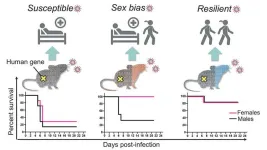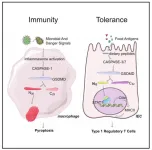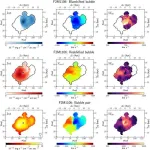(Press-News.org)
Researchers at The Jackson Laboratory have created a panel of genetically diverse mice that accurately model the highly variable human response to SARS-CoV-2 infection. Together with collaborators at NIH’s Rocky Mountain Laboratories, the team uncovered differences in the innate immune and regulated proinflammatory responses, the timing and strength of which are associated with disease severity. Moving forward, the diverse mouse strains will allow scientists to model patient variation in COVID-19 outcome and provide a platform for discovering biomarkers of disease severity, characterizing antiviral immune responses and evaluating countermeasures.
Reproducing variable human response
Early in the COVID-19 pandemic, it became clear that people had hugely variable responses to SARS-CoV-2 infection. Many exhibited no symptoms at all, while a small percentage contracted severe or lethal disease. The timing and strength of innate immune activity and interferon signaling, the front-line cellular defense against microbial infection, were implicated in this variability, but the underlying factors determining disease severity between individuals remained poorly understood.
In response to the pandemic, a mouse model was quickly re-derived that allowed SARS-CoV-2 infection through humanized angiotensin-converting enzyme 2 (hACE2) receptors. At first, the hACE2 was only present in a single inbred mouse line, known as K18-hACE2, which always developed severe/lethal disease. To see whether the variable human response could be replicated in mice, a team of researchers led by The Jackson Laboratory (JAX) Scientific Director and Professor Nadia Rosenthal, Ph.D., F.Med.Sci., and Rocky Mountain National Laboratories Chief of Innate Immunity and Pathogenesis Sonja Best, Ph.D., crossed the original K18-hACE2 line with other mouse strains that represent broad genetic diversity.
In “Genetically diverse mouse models of SARS-CoV-2 infection reproduce clinical variation in type I interferon and cytokine responses in COVID-19,” a paper published in Nature Communications, the team shows that the resulting F1 (first generation crossed) mice indeed modeled human COVID-19 severity, ranging from asymptomatic to lethal. The original genetic background used for the K18-hACE2 mice (C57Bl/6J) proved to be among the most susceptible, while the F1 crosses from a strain known as PWK were highly resistant to disease. F1 progeny of the other crosses, derived from the inbred strains A/J, 129S1, NOD, NZO, CAST, WSB, BALB/c, and DBA/2, had a range of responses mostly between the two extremes. Interestingly, some of them—CAST, NOD, and WSB—also had sex differences, with consistently different levels of disease severity between F1 males and females.
Developing a preclinical platform
With the mouse panel, the team was able to further investigate differences in the innate immune responses that had been implicated in human patient variability. In particular, type 1 interferon (IFN-1) is essential for control of virus replication, where the timing and regulation of the response plays key roles in determining disease severity. If the response is delayed, viral replication and spread can proceed unchecked during the early stages of infection. At the same time, failure to regulate it and reduce signaling once acute infection is over can lead to ongoing inflammation and adverse health consequences.
The research team found that the highly resistant PWK F1 mice exhibited early control of virus replication in the lungs, with phased amplification and resolution of pro-inflammatory responses and prevention of virus dissemination to other organs. In contrast, F1 crosses with the more susceptible strains exhibited relatively inefficient IFN-1 expression in the lung, failed control of virus replication, and dysregulated pro-inflammatory responses. An outlier was WSB, which had high early IFN-1 expression but also high early virus burden in the lung, and clearance was delayed in a manner similar to mice with low IFN-1 expression. WSB may therefore prove valuable for investigating additional pathological responses associated with high IFN-1 expression but low antiviral activity.
There are many gaps in our current knowledge that remain to be addressed, including the exact mechanisms of innate immune control of virus replication, the events needed for a well-orchestrated inflammatory response, the molecular mechanisms of sex-dependent disease severity, and longer-term implications for tissue repair and lung function. Developing a preclinical platform for linking disease outcome to patient genetic features promises to bridge the knowledge gap in our understanding of the underlying differences in COVID-19 susceptibility, facilitating the development of precise models for rapid diagnoses, mechanistic studies and therapeutic intervention strategies.
END
A research team led by Prof. ZHU Shu from the University of Science and Technology of China (USTC) of the Chinese Academy of Sciences (CAS) illustrated the role of Gasdermin D (GSDMD) protein in immunity tolerance to food in the small intestine. The study was published in Cell.
GSDMD, an executioner protein of cell pyroptosis, has garnered widespread attention. When cells are stimulated by pathogen-associated molecular patterns (PAMPs) or damage-associated molecular patterns (DAMPs), the signaling receptors within the cells activate caspase-1/4/5/8/11, leading to the N-terminal cleavage of GSDMD and ...
A team led by Prof. LIU Guilin and Prof. HE Zhicheng from the University of Science and Technology of China (USTC) of the Chinese Academy of Sciences (CAS) discovered superbubble pairs generated by quasar-driven outflows of three red quasars for the first time. This study was published in Science Advances.
The observed number of massive galaxies is significantly lower than the prediction of the current galaxy evolution theory, thus certain mechanism is needed to suppress star formation and modulate the growth of the galaxy. To bridge the gap between theory and observation, an outflow mechanism where a galaxy nucleus drives a massive amount of gas into intergalactic ...
Prof. REN Baohua and his team from the School of Earth and Space Sciences, the University of Science and Technology of China (USTC) of the Chinese Academy of Sciences (CAS), uncovered the connection between Arctic daily warming and the equator region as well as Atlantic storms. The series of studies have been published in npj Climate and Atmospheric Science, Environmental Research Letters, and Advances in Atmospheric Sciences.
As one of the coldest places where the average winter temperature is -30℃, the Arctic temperature has reached the melting point several times, for instance, in late December 2015 and 2022. Those Artic daily warming events ...
A research team led by Professor WANG Jian, the deputy chief designer of the Wide Field Survey Telescope(WFST)and a faculty member of the State Key Laboratory of Nuclear Detection and Nuclear Electronics of the School of Physics, University of Science and Technology of China (USTC) of the Chinese Academy of Sciences(CAS), carried out the key technology of the main focus camera. The results were published in IEEE Transactions on Instrumentation and Measurement in July ...
The research team led by Prof. LIU Xianwei from the Department of Environmental Science and Engineering of University of Science and Technology of China (USTC) of the Chinese Academy of Science (CAS) has made progress in the dynamic imaging of interfacial electrochemistry. The results were published in Nature Communications under the title of "Dynamic Imaging of Interfacial Electrochemistry on Single Ag Nanowires by Azimuth-modulated Plasmonic Scattering ...
A research team led by Prof. WU Dong from the University of Science and Technology of China (USTC) of the Chinese Academy of Sciences (CAS) proposed a femtosecond laser 2-in-1 writing multi-material processing strategy to fabricate micromachined joints composed of temperature-sensitive hydrogels and metal nanoparticles, and developed multi-jointed humanoid micromachines with multiple deformation modes (>10). The results were published in Nature Communications.
In recent years, femtosecond laser two-photon polymerization, as a true three-dimensional fabrication technique ...
Lasers are an essential tool for materials processing. They can be used to cut, weld and remove material. A special kind of lasers known as femtosecond lasers can be used to create high-precision microstructures, such as those needed for smartphone displays and automotive technology. Professor Clara Saraceno from Ruhr University Bochum aims to introduce a cheaper and more efficient laser technology to the market. To this end, she is receiving a proof-of-concept grant amounting to 150,000 euros from the European Research ...
A new study presents a promising treatment method for so-called fusion-driven cancers, which are currently often difficult to cure. These fusion-driven cancers are caused by an error in cell division that creates a fusion of different genes. This fusion causes the cancer and drives the uncontrolled cell growth.
Using the so-called molecular scissors CRISPR/Cas9, researchers from Aarhus University have developed a gene therapy that can stop cell division in a subtype of the aggressive blood cancer acute myeloid leukaemia (AML).
The study has just been published in the scientific journal Leukemia. Even though the ...
A new study reports conclusive evidence for the breakdown of standard gravity in the low acceleration limit from a verifiable analysis of the orbital motions of long-period, widely separated, binary stars, usually referred to as wide binaries in astronomy and astrophysics. The study carried out by Kyu-Hyun Chae, professor of physics and astronomy at Sejong University in Seoul, used up to 26,500 wide binaries within 650 light years (LY) observed by European Space Agency’s Gaia space telescope. Kareem El-Badry, then at Harvard and now a faculty at ...
Receiving therapy for problematic social media use can be effective in improving the mental wellbeing of people with depression, finds a new study by UCL researchers.
The research, published in the Journal of Medical Internet Research, found that social media use interventions could help adults for whom social media use has become problematic or interferes with their mental health.
Problematic use is when a person’s pre-occupation with social media results in a distraction from their primary tasks and the neglect of responsibilities in other aspects of their life.
Previous research* has suggested that social media use can become problematic ...





